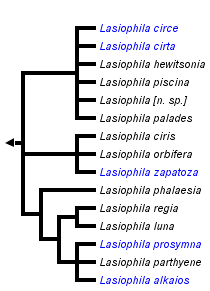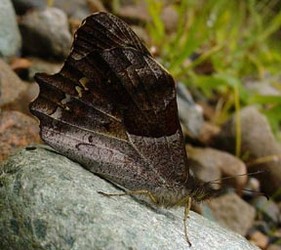Lasiophila
Andrew V. Z. Brower


This tree diagram shows the relationships between several groups of organisms.
The root of the current tree connects the organisms featured in this tree to their containing group and the rest of the Tree of Life. The basal branching point in the tree represents the ancestor of the other groups in the tree. This ancestor diversified over time into several descendent subgroups, which are represented as internal nodes and terminal taxa to the right.

You can click on the root to travel down the Tree of Life all the way to the root of all Life, and you can click on the names of descendent subgroups to travel up the Tree of Life all the way to individual species.
For more information on ToL tree formatting, please see Interpreting the Tree or Classification. To learn more about phylogenetic trees, please visit our Phylogenetic Biology pages.
close boxCharacteristics
Species of Lasiophila can be recognized by the crenolated hindwing margins, often developed into one or more "tails." The dorsal surfaces of the wings are reddish brown with paler spots, and some species have conspicuous white patches.
Discussion of Phylogenetic Relationships
The tree is based on Pyrcz' (1999, 2006) discussion of relationships in the genus. He divided the species into three groups based on morphological and ecological traits (altitudinal distribution in the Andes).
References
Lamas G ed. 2004. Atlas of Neotropical Lepidoptera. Checklist: Part 4A Hesperioidea - Papiionoidea. Gainesville: Scientific Publishers/Association of Tropical Lepidoptera.
Pyrcz, T. W. 1999 Contribution to the knowledge of Ecuadorian Pronophilini. Part II. The genus Lasiophila (Lepidoptera: Nymphalidae: Satyrinae). Genus (Wroclaw) 10, 479-495.
Pyrcz, T. W. 2006 Filling the gaps in the distribution patterns of the genus Lasiophila C. & R. Felder: a new speceis from the valley of Kos˝ipata (Cuzco, Peru) (Lepidoptera: Nymphalidae: Satyrinae). Genus (Wroclaw) 17, 601-608.
Title Illustrations

| Scientific Name | Lasiophila orbifera |
|---|---|
| Location | Ecuador: San Isidro |
| Specimen Condition | Live Specimen |
| Identified By | Kim Garwood |
| Life Cycle Stage | adult |
| View | ventral |
| Source | Orbifera Satyr (Lasiophila orbifera) |
| Source Collection | Neotropical Butterflies |
| Copyright | © 2004 Kim Garwood |
About This Page

Middle Tennessee State University, Murfreesboro, Tennessee, USA
Correspondence regarding this page should be directed to Andrew V. Z. Brower at
Page copyright © 2011
 Page: Tree of Life
Lasiophila .
Authored by
Andrew V. Z. Brower.
The TEXT of this page is licensed under the
Creative Commons Attribution License - Version 3.0. Note that images and other media
featured on this page are each governed by their own license, and they may or may not be available
for reuse. Click on an image or a media link to access the media data window, which provides the
relevant licensing information. For the general terms and conditions of ToL material reuse and
redistribution, please see the Tree of Life Copyright
Policies.
Page: Tree of Life
Lasiophila .
Authored by
Andrew V. Z. Brower.
The TEXT of this page is licensed under the
Creative Commons Attribution License - Version 3.0. Note that images and other media
featured on this page are each governed by their own license, and they may or may not be available
for reuse. Click on an image or a media link to access the media data window, which provides the
relevant licensing information. For the general terms and conditions of ToL material reuse and
redistribution, please see the Tree of Life Copyright
Policies.
- First online 01 November 2006
- Content changed 21 June 2008
Citing this page:
Brower, Andrew V. Z. 2008. Lasiophila . Version 21 June 2008 (under construction). http://tolweb.org/Lasiophila/82825/2008.06.21 in The Tree of Life Web Project, http://tolweb.org/







 Go to quick links
Go to quick search
Go to navigation for this section of the ToL site
Go to detailed links for the ToL site
Go to quick links
Go to quick search
Go to navigation for this section of the ToL site
Go to detailed links for the ToL site